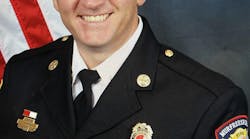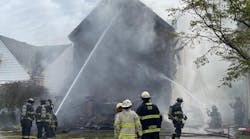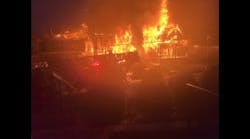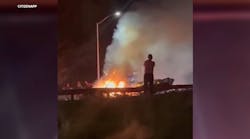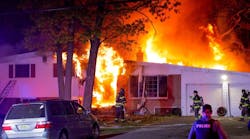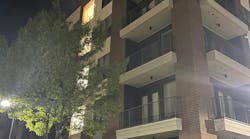Chronology
The spring SWI fire season started off slowly in certain areas of the United States due to cool, wet weather from the effects of the El Nino phenomenon. However, in sharp contrast, the areas from Texas to Georgia were hotter and drier than normal and drought index readings were on the rise.
In my home state of Massachusetts, SWI fire activity was slow to moderate and sporadic, as was the case in the northeastern United States. Massachusetts recorded 2,284 reported wildland fires that burned 2,689 acres. During a dry period in the fall, a few moderate-size fires occurred several miles to the west and southwest of Boston and several other locations across the state. Statewide, SWI fires damaged a small number of structures during 1998.
The months of May, June and July brought tremendous wildland and SWI fires to Florida, Georgia, Texas and Oklahoma. Significant fire activity occurred in August and September as hot and dry conditions persisted throughout most of the western United States. Arizona, California, Washington, Idaho and Utah experienced significant large-scale wildland and SWI fires.
Specially trained Interagency Fire Prevention and Education Teams were deployed to many of the states that were experiencing or could experience significant wildland and SWI fire activity. These highly successful teams use a proactive approach in educating the public about wildland fire dangers that ultimately leads to a reduction of human-caused fires.
According to the National Interagency Fire Center (NIFC) Office of Public Affairs in Boise, ID, overall, the U.S. wildland fire season was relatively slow compared to recent years (obviously not the case in Florida and Texas). As of Nov. 30, there were a total of 76,500 reported wildland fires burning 2,281,605 acres in the U.S. By contrast in 1996, a very intense and long fire season, NIFC reported 96,363 fires affecting 6,692,708 acres.
At the 1998 Fire Service Leadership Summit held in St. Louis in August, Garry Briese, executive director of the International Association of Fire Chiefs ( IAFC), stated, "Fire is not a priority to public officials in this country. In their minds, America's not burning anymore. The only part of the fire problem that's growing in the United States is the wildland/urban interface (SWI) fire problem."
I agree wholeheartedly with Mr. Briese's accurate statement about the expanding SWI fire problem. My question to him and the IAFC, et al, is what measures are you and your association taking to help mitigate this major fire service conundrum?
Wildfires In Other Countries
By mid-May, hundreds of wildland fires were blazing across Mexico and portions of Central America. Belize, Costa Rica, El Salvador, Guatemala, Honduras, Mexico and Nicaragua were under a fire siege. Smoke from these fires filtered into Arizona, Louisiana, New Mexico, Oklahoma and Texas.
On May 15, NIFC coordinated requests from the U.S. Agency for International Development (AID) Office of Foreign Disaster Assistance for firefighting resources to be sent to Mexico and the Central American countries that were hit hard by these massive fires. By late June, the fires subsided and it was determined that over one million acres had been burned in Mexico alone. Much of the vegetation that held the land together in these countries had been burned away. As the torrential rains from Hurricane Mitch inundated some of these countries, floods and mudslides "of biblical proportions" destroyed villages and killed thousands of inhabitants.
Canada experienced significant wildfire activity during its entire fire season. By late September, 10,466 fires had burned over 4,462,743 hectares, which equals 11,027,437 acres. The NIFC filled aid requests from Canada by sending infrared aircraft to map fires, 11 firefighting crews, supplies, radios and other equipment.
Five volunteer firefighters died in the line of duty in the Australian state of Victoria on Dec. 2, 1998, as they were overrun by fire during that country's first major bushfire of the year. They were fighting to save the small town of Linton. More than 300 firefighters using 42 engines and five aircraft battled the flames that at one time were burning along a two-mile front.
In Conclusion
According to the National Interagency Fire Center (NIFC) in Boise, ID, in its weekly report of Nov. 28: "There was moderate fire activity in the southern area of the United States. Virginia was in high fire danger. During a wildland fire, a Virginia Department of Forestry tractor/bulldozer operator was overrun by fire and received minor burns."
Also in Virginia, dry conditions and high winds have caused two large wildfires to consume nearly 2,500 acres as of Dec. 3. Fifteen federal, state, local and out-of-state hand crews were working these fires.
Ann Arundel County, MD, Fire and Rescue Services has experienced a significant increase in SWI fire activity this year due to unusually dry conditions. From Jan. 1 to Dec. 3, 1998, there were 1,366 responses to SWI fires in the county. That is nearly double the usual fires in any given year.
Since July, the county has instituted a "Brush Box" response of two engines, two brush fire units and a battalion chief on the report of a wildland fire. Fifteen alarms were transmitted on Nov. 24 to contain two simultaneously ignited fires. No structures have been damaged, but smoke from some of these fires has caused health problems among those with chronic respiratory ailments.
Fire analysts are predicting that Florida may experience yet another fire siege during the winter of 1998/99 if significant rains don't fall on the Sunshine State. Let's hope that it rains just enough to prevent another fire siege, but that the sun will shine enough to make the Florida Chamber of Commerce and its winter residents and tourists smile, warmly.
The wildland and SWI fires were statistically down during 1998, nationwide, excepting Florida and Texas. Thankfully, loss of life to civilians and firefighters were also down. And that is of significant importance.
Yet, these fires are weather-driven events. During 1999, we may see dramatic increases in wildland and SWI fire activity if the weather turns hot, dry and windy. The structural and wildland firefighting communities must move ahead and prepare for worst-case scenarios.
As surely as the sun rises there will be wildland and SWI fires in many areas of this country and around the world. How successfully the fire services mitigate, control and suppress these oftentimes destructive fires is dependent on how well we are prepared.
Be very careful out there. It can get very dangerous very quickly! Have a happy, healthy and safe New Year.
Robert M. Winston, a Firehouse® contributing editor, is a district fire chief in the Boston Fire Department with extensive experience and training in wildland and SWI protection. Questions and comments may be sent to him via e-mail at [email protected].


